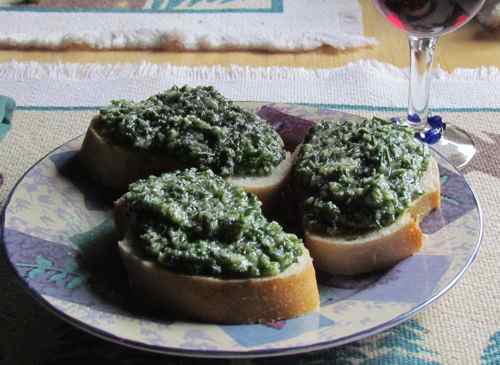Even though we spend a lot of time and energy extracting maximum benefit from our garden, it’s taken us a while to address the annual overabundance of chives.
Chives grow really, really well here. We have clumps growing around the garden, and in the outer patches along the beach edge and elsewhere. We’ve divided, given away several times, use chives liberally in our cooking, and dry them. Still, most of the chives we raise go unused each year. Last autumn, as I gazed at the remaining clumps of chives, grown woody and harsh, I resolved to find a way to use a lot of chives in a really tasty way.
Now, we’ve got more chives than ever before. And I have discovered chive pesto.
Pesto had to be the obvious first step. We adore pesto, especially when we make it with chickweed and other non-garden plants around the cabin (see Am I Working Too Hard? Bumbleweed Pesto). We had long speculated on making pesto with chives, but worried about how it might behave in the blender. This, as you’ll see, was a legitimate concern.
I went on line and found a couple of different recipes for chive pesto. As with many recipes, I found them wanting, primarily in their far-too-timid application of garlic. I glanced over the basics, then went to work.
Here’s what I came up with:
________________________________________________
Zeiger Homestead Chive Pesto
4 cups of chopped chives
1 cup olive oil
1 cup Parmesan cheese
2-4 cloves garlic
Cut chives into lengths, 1 inch or so.
If you have a food processor, blend chives, cheese, and garlic in short bursts until mixed. Add olive oil.
By hand, mince chives and garlic, then add and mix in cheese. Add olive oil as above.
________________________________________________
I tried the first batch in the blender, but the light, hollow chives didn’t blend well. Since then, I’ve processed it by hand. It’s more time consuming, but it’s more energy efficient, and there’s less clean up required.
I had feared that a chive pesto would be overwhelming, and it may be for some people. I assume this is why most recipes called for 1 clove of garlic (what—are they kidding?). We like onions and garlic, so it’s not too strong for us by any means.
With the proportions above, I find it very easy to scale the recipe up or down as needed. As a result, we get to eat pesto a lot more often, on a greater variety of foods.
I’m really glad to have worked this out. We get chives in the yard far earlier than we get chickweed, so our pesto season has expanded considerably. It also addresses our overabundance of chives, as 4 cups accounts for most of a bunch. Underutilization won’t be a problem anymore!

